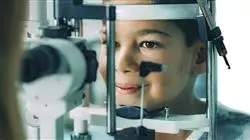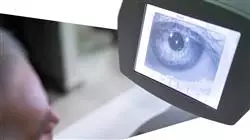University certificate
The world's largest faculty of medicine”
Introduction to the Program
Keep up to date with the latest advances and developments in Pediatric Ophthalmology, ensuring your practice benefits from the latest research and technology”

In today's medical landscape, Pediatric Ophthalmology emerges as a discipline of vital importance in the care of children's health. In a world characterized by a constant flow of technological and scientific advances, as well as a change in the health care needs of the population, pediatric ophthalmology professionals face unique and crucial challenges.
The increasing incidence of eye disorders in children, as well as the complexity of diagnosing and treating these conditions in a population that is often unable to express their symptoms effectively, demands a level of competence and knowledge that evolves at the same pace as the changing demands of the field.
It is in this context that the Masters Degree in Pediatric Ophthalmology stands as a comprehensive response to the challenges faced by specialists. This program has been meticulously designed to provide participants with a thorough and up-to-date understanding of pediatric ophthalmology today. Therefore, the degree is taught exclusively online, providing medical professionals and specialists with the necessary flexibility to access updated content without interrupting their clinical practice.
In this way, the specialist will have a diversity of multimedia content focused on the most rigorous clinical practice. Access to them is unrestricted, and they are an essential working guide that will continue to be useful even after completion of the program.
Take advantage of the flexibility of our online program, designed to fit your professional schedule, and access all the up-to-date content without sacrificing your clinical commitment"
This Masters Degree in Pediatric Ophthalmology contains the most complete and up-to-date scientific program on the market. The most important features include:
- Practical case studies presented by experts in Pediatric comprises
- The graphic, schematic, and practical contents with which they are created, provide scientific and practical information on the disciplines that are essential for professional practice
- Practical exercises where the self-assessment process can be carried out to improve learning
- Its special emphasis on innovative methodologies
- Theoretical lessons, questions to the expert, debate forums on controversial topics, and individual reflection assignments
- Content that is accessible from any fixed or portable device with an Internet connection
Get ready to face the most complex challenges in Pediatric Ophthalmology with this Masters Degree"
The program’s teaching staff includes professionals from the field who contribute their work experience to this educational program, as well as renowned specialists from leading societies and prestigious universities.
The multimedia content, developed with the latest educational technology, will provide the professional with situated and contextual learning, i.e., a simulated environment that will provide immersive education programmed to learn in real situations.
This program is designed around Problem-Based Learning, whereby the professional must try to solve the different professional practice situations that arise during the academic year For this purpose, the students will be assisted by an innovative interactive video system created by renowned and experienced experts.
Deepen in the early identification of visual problems in children, playing a crucial role in the preservation of vision"

Develop competencies directly applicable to your daily clinical practice, perfecting your ability to diagnose and treat opthalmological conditions"
Why study at TECH?
TECH is the world’s largest online university. With an impressive catalog of more than 14,000 university programs available in 11 languages, it is positioned as a leader in employability, with a 99% job placement rate. In addition, it relies on an enormous faculty of more than 6,000 professors of the highest international renown.

Study at the world's largest online university and guarantee your professional success. The future starts at TECH”
The world’s best online university according to FORBES
The prestigious Forbes magazine, specialized in business and finance, has highlighted TECH as “the world's best online university” This is what they have recently stated in an article in their digital edition in which they echo the success story of this institution, “thanks to the academic offer it provides, the selection of its teaching staff, and an innovative learning method aimed at educating the professionals of the future”
A revolutionary study method, a cutting-edge faculty and a practical focus: the key to TECH's success.
The most complete study plans on the university scene
TECH offers the most complete study plans on the university scene, with syllabuses that cover fundamental concepts and, at the same time, the main scientific advances in their specific scientific areas. In addition, these programs are continuously being updated to guarantee students the academic vanguard and the most in-demand professional skills. In this way, the university's qualifications provide its graduates with a significant advantage to propel their careers to success.
TECH offers the most comprehensive and intensive study plans on the current university scene.
A world-class teaching staff
TECH's teaching staff is made up of more than 6,000 professors with the highest international recognition. Professors, researchers and top executives of multinational companies, including Isaiah Covington, performance coach of the Boston Celtics; Magda Romanska, principal investigator at Harvard MetaLAB; Ignacio Wistumba, chairman of the department of translational molecular pathology at MD Anderson Cancer Center; and D.W. Pine, creative director of TIME magazine, among others.
Internationally renowned experts, specialized in different branches of Health, Technology, Communication and Business, form part of the TECH faculty.
A unique learning method
TECH is the first university to use Relearning in all its programs. It is the best online learning methodology, accredited with international teaching quality certifications, provided by prestigious educational agencies. In addition, this disruptive educational model is complemented with the “Case Method”, thereby setting up a unique online teaching strategy. Innovative teaching resources are also implemented, including detailed videos, infographics and interactive summaries.
TECH combines Relearning and the Case Method in all its university programs to guarantee excellent theoretical and practical learning, studying whenever and wherever you want.
The world's largest online university
TECH is the world’s largest online university. We are the largest educational institution, with the best and widest online educational catalog, one hundred percent online and covering the vast majority of areas of knowledge. We offer a large selection of our own degrees and accredited online undergraduate and postgraduate degrees. In total, more than 14,000 university degrees, in eleven different languages, make us the largest educational largest in the world.
TECH has the world's most extensive catalog of academic and official programs, available in more than 11 languages.
Google Premier Partner
The American technology giant has awarded TECH the Google Google Premier Partner badge. This award, which is only available to 3% of the world's companies, highlights the efficient, flexible and tailored experience that this university provides to students. The recognition as a Google Premier Partner not only accredits the maximum rigor, performance and investment in TECH's digital infrastructures, but also places this university as one of the world's leading technology companies.
Google has positioned TECH in the top 3% of the world's most important technology companies by awarding it its Google Premier Partner badge.
The official online university of the NBA
TECH is the official online university of the NBA. Thanks to our agreement with the biggest league in basketball, we offer our students exclusive university programs, as well as a wide variety of educational resources focused on the business of the league and other areas of the sports industry. Each program is made up of a uniquely designed syllabus and features exceptional guest hosts: professionals with a distinguished sports background who will offer their expertise on the most relevant topics.
TECH has been selected by the NBA, the world's top basketball league, as its official online university.
The top-rated university by its students
Students have positioned TECH as the world's top-rated university on the main review websites, with a highest rating of 4.9 out of 5, obtained from more than 1,000 reviews. These results consolidate TECH as the benchmark university institution at an international level, reflecting the excellence and positive impact of its educational model.” reflecting the excellence and positive impact of its educational model.”
TECH is the world’s top-rated university by its students.
Leaders in employability
TECH has managed to become the leading university in employability. 99% of its students obtain jobs in the academic field they have studied, within one year of completing any of the university's programs. A similar number achieve immediate career enhancement. All this thanks to a study methodology that bases its effectiveness on the acquisition of practical skills, which are absolutely necessary for professional development.
99% of TECH graduates find a job within a year of completing their studies.
Master's Degree in Pediatric Ophthalmology
Pediatric ophthalmology is an invaluable investment in the future of our children. Caring for ocular health from an early age is key to optimal development and academic success. Are you ready to take a significant leap in your career? The Faculty of Medicine at TECH Global University offers you an exceptional opportunity through the Master's Degree in Pediatric Ophthalmology, which you can complete online. By joining our program, you will acquire specialized skills that will allow you to effectively diagnose and treat ocular conditions in children. Our team of instructors, made up of experts in the field, will guide you throughout your learning journey, providing you with the most up-to-date knowledge and the most advanced techniques in Pediatric Ophthalmology. What will you learn in our course? During the program, you will explore topics such as strabismus, amblyopia, congenital eye diseases, and much more. Additionally, you will develop the ability to perform specific ophthalmological exams for children, enabling you to provide high-quality care.
Learn pediatric ophthalmology with online classes
Studying here is a unique opportunity. Our university stands out for its focus on innovation and academic excellence. You will join a community of students and professionals who share your passion for Pediatric Ophthalmology. The goal of our degree is to prepare you to become a highly skilled specialist in pediatric ophthalmology. Upon completion, you will receive an internationally recognized certificate that will open doors to a wide range of professional opportunities in hospitals, specialized clinics, and even the possibility of establishing your own practice. In summary, our Master's Degree in Pediatric Ophthalmology is your pathway to an exciting and rewarding career. Are you ready to take the next step in your medical career and make a difference in children's ocular health? Join us and start your journey toward success in Pediatric Ophthalmology!







